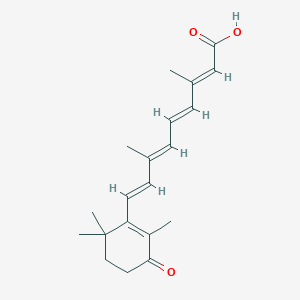Detail Information of Xenobiotics
| General Information of Xenobiotics (ID: XEO01154) | ||||||
|---|---|---|---|---|---|---|
| Xenobiotics Name |
4-oxoretinoic acid
|
|||||
| Xenobiotics Type |
Natural Product(s), Extract(s) or Medicine(s)
|
|||||
| Classification |
Natural Product
|
|||||
| Structure |
<iframe style="width: 300px; height: 300px;" frameborder="0" src="https://embed.molview.org/v1/?mode=balls&cid=6437063"></iframe>
|
 |
||||
| 3D MOL | 2D MOL | |||||
| PubChem CID | ||||||
| DME(s) Modulated by This Xenobiotics | ||||||
| DME(s) Inhibited by This Xenobiotics | ||||||
| Vitamin D(3) 25-hydroxylase (CYP27A1) | DME Info | Homo sapiens | [1] | |||
| Cytochrome P450 3A7 (CYP3A7) | DME Info | Homo sapiens | [1] | |||
| Lauric acid omega-hydroxylase (CYP4A11) | DME Info | Homo sapiens | [1] | |||
| Glutathione S-transferase mu-1 (GSTM1) | DME Info | Homo sapiens | [1] | |||
| Prostaglandin G/H synthase 1 (COX-1) | DME Info | Homo sapiens | [1] | |||
| Prostaglandin G/H synthase 2 (COX-2) | DME Info | Homo sapiens | [1] | |||
| Sulfotransferase 2A1 (SULT2A1) | DME Info | Homo sapiens | [1] | |||
| Transglutaminase K (TGM1) | DME Info | Homo sapiens | [1] | |||
| DME(s) Induced by This Xenobiotics | ||||||
| Retinoic acid 4-hydroxylase 26A1 (CYP26A1) | DME Info | Homo sapiens | [2] | |||
| Glutamine synthetase (GLUL) | DME Info | Homo sapiens | [1] | |||
| Transglutaminase H (TGM2) | DME Info | Homo sapiens | [3] | |||
If you find any error in data or bug in web service, please kindly report it to Dr. Yin and Dr. Li.

